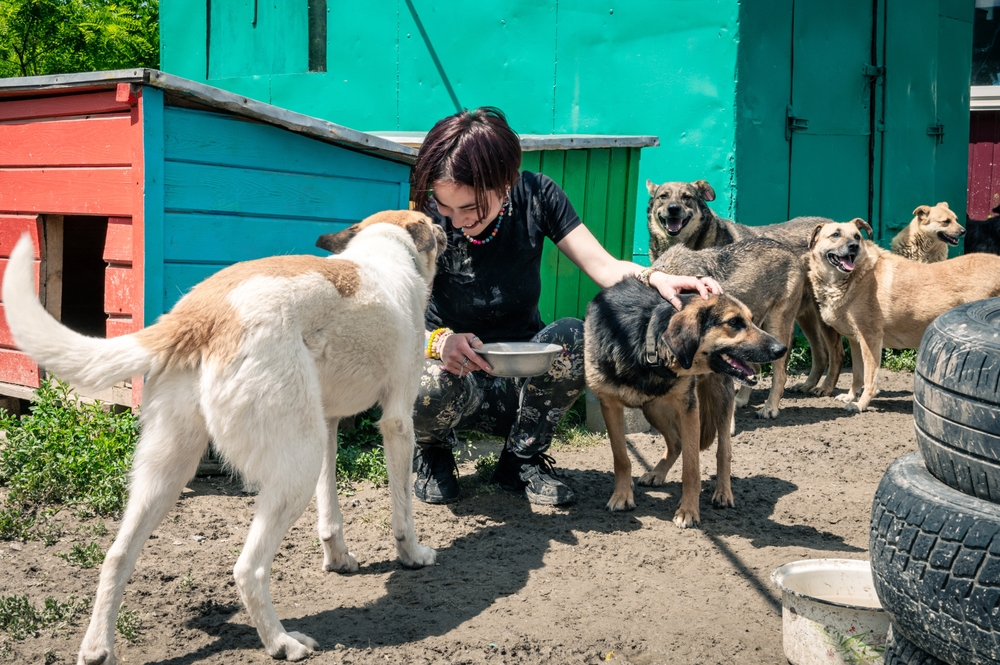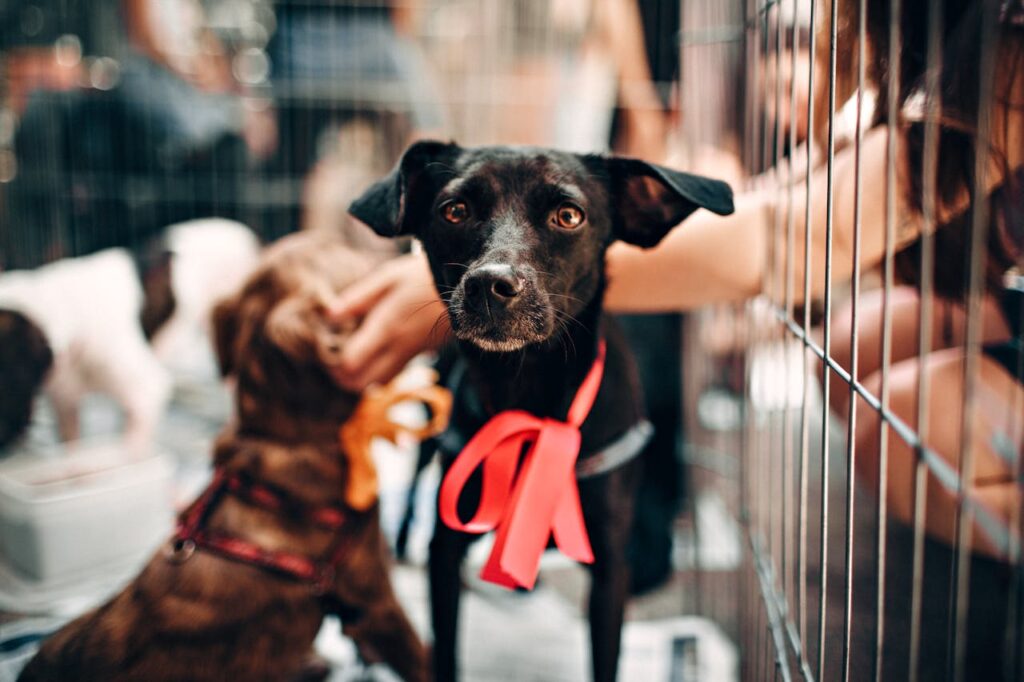Two animal shelters celebrating empty kennels after all dogs got adopted for the first time ever

There are moments in life when silence says more than a thousand cheers ever could. Not the silence of emptiness, but the kind that hums with purpose — the kind that follows a job well done, a mission fulfilled, a heart finally at rest. In Gettysburg, Pennsylvania, that kind of silence echoed through the halls of the Adams County SPCA this past Christmas. For the first time in nearly fifty years, their dog kennels were empty. Not because the need disappeared, but because people showed up. Chose love. Chose action.
In a world flooded with headlines of division, disaster, and despair, it’s easy to feel numb. Easy to believe that real change is out of reach. But sometimes, a quiet victory like this reminds us that hope isn’t mythical. It’s measurable. And it begins in the everyday choices we make — who we love, how we serve, where we step in.

A Moment of Silence — And Celebration
For nearly half a century, the kennels at the Adams County SPCA in Gettysburg, Pennsylvania, were never truly quiet. The sounds of barking, the scuffle of paws, the longing eyes of dogs waiting behind chain-link barriers — it was the norm. But this year, just days before Christmas, that norm was broken. For the first time in 47 years, the shelter had not a single dog left. Every kennel stood empty, not from lack of need — but because every single dog had been adopted into a loving home. What was once noise became silence. Not a silence of loss — but of peace.
The staff and volunteers, who had poured their energy into cleaning, feeding, nurturing, and matchmaking, could finally pause and take in the magnitude of the moment. This wasn’t a fluke. Just two weeks prior, their kennels were nearly full. But then the community showed up — again. Individuals and families stepped forward to adopt, one after another, until the shelter found itself in an unprecedented state of celebration. As of December 22, only one new stray cat had entered the building. For the dogs, there were no more cages. Just couches, backyards, and fresh starts.
To the Adams County SPCA team, it felt like a miracle — and in many ways, it was. But it was also the result of tireless, intentional work. The nonprofit typically houses around 25 dogs and up to 50 cats. This milestone didn’t happen because demand disappeared; it happened because people were moved to act. And now, with their kennels empty, the shelter plans to continue their mission by taking in animals from nearby facilities in Pennsylvania, extending their impact even further. This wasn’t just a holiday miracle — it was a community triumph, years in the making.

The Power of Community Compassion
What happened in Gettysburg wasn’t just a local success story — it was a masterclass in what collective compassion can look like when it moves from thought to action. Too often, we hear about overcrowded shelters, animals spending months — sometimes years — waiting to be seen, to be chosen. But when a community recognizes its power to intervene, everything can change. The Adams County SPCA didn’t just empty because people wanted to feel good for the holidays. It emptied because people understood the responsibility of care — and chose to act on it.
Behind every adopted dog was a decision. A decision to show up. To rearrange schedules, to take on the challenges of pet ownership, to offer patience and love to an animal that may have experienced abandonment, fear, or trauma. These choices aren’t small. They reflect a mindset shift — one where people no longer see shelter animals as someone else’s problem, but as beings worthy of their time, effort, and home. That kind of thinking doesn’t just benefit the animals — it transforms the people who adopt them. Numerous studies have shown the emotional and mental health benefits of pet adoption, from reduced loneliness and stress to a greater sense of purpose and routine.
And let’s not forget the role of the shelter staff and volunteers. They didn’t just facilitate adoptions — they nurtured trust, both with the animals and the adopters. Every successful adoption is the result of work done quietly and consistently behind the scenes: behavioral assessments, medical care, socialization, and the often-overlooked task of ensuring each dog was matched with the right home. That kind of care takes more than training — it takes heart. And when a community supports that heart with donations, adoptions, and outreach, it creates the kind of outcome that once seemed impossible. An empty shelter, not because there were no needs, but because those needs were met — fully, intentionally, and together.
Why Empty Shelters Shouldn’t Be the Exception
While the empty kennels at Adams County SPCA made headlines, they also raise an important question: why is this moment so rare? Why is it news when a shelter is empty, rather than expected? Across the country, tens of thousands of dogs and cats still wait in shelters — some for weeks, others for years — hoping for a chance at a life outside concrete walls. According to the ASPCA, approximately 3.1 million dogs enter U.S. animal shelters each year. While many are adopted, about 390,000 dogs are still euthanized annually due to overcrowding or lack of resources. That’s not a statistic — that’s a call to action.
The fact that Adams County’s success stands out reveals how deeply we’ve normalized animal homelessness. Shelters are often overburdened, underfunded, and staffed by people running on equal parts compassion and exhaustion. Even in communities with kindhearted people, adoption rates often lag because of misinformation, fear of behavioral issues, or the misconception that shelter animals are “damaged goods.” But here’s the truth — many of these animals end up in shelters not because they’re broken, but because humans failed them. They were surrendered due to moves, lifestyle changes, lack of training, or economic hardship. They’re not broken. They’re just waiting for someone to believe they’re worth saving.
What happened in Gettysburg is a glimpse of what’s possible when those beliefs shift — when a town collectively decides that these animals deserve a second chance. It shows what can happen when shelters are supported not just with sympathy, but with action. Imagine a world where shelters are routinely empty, not because we’ve turned a blind eye, but because our communities are so responsive, so engaged, that dogs and cats spend only days — not years — waiting for a home. That world isn’t out of reach. It just takes more people leaning in, stepping up, and recognizing that compassion isn’t just a feeling. It’s a choice we make, again and again.
What This Teaches Us About Hope, Action
At its core, the story of the Adams County SPCA isn’t just about dogs — it’s about the quiet power of consistent care and the massive ripple effects that small, intentional actions can create. It’s easy to feel overwhelmed by the scale of suffering in the world — whether it’s homelessness, mental health crises, climate change, or even the loneliness epidemic that many of us are silently battling. But the truth is, most change doesn’t start with a grand gesture. It starts with one person doing one thing — walking into a shelter, saying “yes” to a dog no one else noticed, showing up when it’s inconvenient.
When we look at this shelter’s transformation, what we’re really seeing is a pattern that applies far beyond animal rescue. It reminds us that hope isn’t something we stumble upon — it’s something we create, together. The volunteers didn’t stop showing up even when the kennels were full. The community didn’t stop caring even when they could’ve told themselves it wasn’t their problem. And in doing so, they didn’t just save dogs — they reminded everyone watching that despair isn’t permanent. Systems, no matter how old or broken, can be healed when people decide to care consistently and collectively.
This moment also teaches us the importance of visibility. When stories like this are shared, they invite others to reimagine what’s possible in their own communities. Someone halfway across the country might read about an empty kennel in Pennsylvania and decide to visit their local shelter. A teacher might share it in a classroom. A child might ask their parents to adopt. The impact doesn’t stop at state lines — it travels. That’s how movements start. That’s how culture changes. One spark, one post, one adopted dog at a time. So the real legacy of this event isn’t just the empty cages — it’s the lives that will change because people dared to believe that change is possible.
From Empty Kennels to Full Hearts: Your Role in the Story
So here we are — a story that began with empty cages and ended with something far greater: a mirror held up to all of us. Because as beautiful as this moment was for the Adams County SPCA, it’s not just their story. It’s a reminder that every one of us has a role to play in shaping the world around us — not just in animal welfare, but in every corner where hope feels scarce and help feels overdue.
You don’t need to adopt a dog tomorrow to make a difference — though if you feel called to, that’s beautiful. But there are other ways to show up. Support your local shelters. Volunteer. Foster. Share adoptable animals on your social feed. Teach your children that kindness extends beyond species. Or zoom out even further — and ask yourself where else in your life you’ve been waiting for “someone else” to care first. Because here’s the truth: the world changes when ordinary people decide to do something extraordinary — and sometimes, that extraordinary thing is simply showing up.
This moment — an empty shelter at Christmas — isn’t just a feel-good headline. It’s a blueprint. A challenge. A possibility. What if more towns saw this not as a one-time miracle, but a standard to reach for? What if we measured community success not just by wealth or progress, but by how well we care for the voiceless, the vulnerable, the overlooked? Whether it’s an animal in a kennel, a neighbor in need, or a part of yourself you’ve been neglecting — remember this: nothing is too far gone. With enough care, consistency, and courage, even the most crowded spaces can be made beautifully empty… and beautifully full.
Loading...

